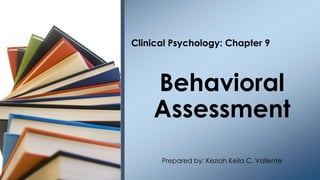
Behavioral assessment - Clinical Psychology
- 1. Clinical Psychology: Chapter 9 Behavioral Assessment Prepared by: Keziah Keila C. Vallente
- 2. What is Behavioral Assessment? • An assessment approach that focuses on the interactions between situations and behaviors for the purpose of effecting behavioral change. How does it differ from Traditional Assessment? 1. Behavioral Assessment emphasizes direct assessments (naturalistic observations) of problematic behavior, antecedent (situational)conditions, and consequences (reinforcement). 2. It has a central feature namely the functional analysis, in where careful analyses are made of the stimuli preceding a behavior and the consequences following from it to gain a precise understanding of the context and causes of behavior. 3. It is an ongoing process, occurring at all points throughout the treatment.
- 3. SORC Model (Kanfer & Phillips, 1970) -a useful model for conceptualizing a clinical problem from a behavioral perspective. • S=stimulus or antecedent conditions that bring on the problematic behavior • O=organismic variable related to the problematic behavior • R=response or problematic behavior • C=Consequences of the problematic behavior
- 4. Behavioral Assessment Methods Behavioral Interviews • Interviews conducted for the purpose of identifying a problem behavior, the situational factors that maintain the behavior, and the consequences that result from that behavior. • Behavioral Interviews are used to obtain a general picture of the presenting problem and of the variables that seem to be maintaining the problematic behavior. Observation Methods • A primary technique of behavioral assessment. It is often used to gain a better understanding of the frequency, strength, and pervasiveness of the problem behavior as well as the factors that are maintaining it. • It provide the clinician with an actual sample (rather than a self - report) of the problematic behavior.
- 5. Observation Methods Naturalistic Conditions • Behavior typically and spontaneously occurs. Controlled Conditions • Simulated or contrived conditions. The environment is designed to such that it is likely that the assessor will observe the targeted behavior or interactions. Home Observation School Observation Hospital Observation • Achenbach’s (1994) Direct Observation Form (DOF) of the Child Behavior Checklist. It is used to assess problem behaviors that may be observed in school classrooms or other settings. • Behavioral Coding System (BCS) developed by Patterson (1977) and his colleagues R.R. Jone, Reid, & Patterson (1975). This observational system was designed for use in the homes of pre – delinquent boys who exhibit problems in the areas of aggressiveness and non – compliance. • Time Sample Behavioral Checklist (TSBC) developed by Gordon Paul and his associates (Mariotto & Paul, 1974). It is a time – sample behavioral checklist that can be used with chronic psychiatric patients. Time – sample means that observations are made at regular intervals for a given patient.
- 6. Controlled Performance Technique • An assessment procedure in which the clinician places individuals in carefully controlled performance situations and collects data on their performance/behaviors, their emotional reactions, and/or various psycho physiological indices. Self - Monitoring • An observational technique in which individuals observe and record their own behaviors, thoughts, or emotions (including information on timing, frequency, intensity and duration), • Clients are asked to maintain behavioral logs or diaries over some predetermined time period.
- 7. Role – Playing Methods • A technique in which patients are directed to respond the way they would typically respond if they were in a given situation. The situation may be described to them, or an assistant may actually act the part of another person. Cognitive – Behavioral Assessments • An assessment approach recognizing that the person’s thought or cognitions play an important role in behavior.
- 8. Variables Affecting Reliability of Observations Complexity of Target Behavior • The more complex the behavior to be observed, the greater the opportunity for unreliability. • Behavioral assessment typically focuses on less complex, lower level behaviors (Haynes, 1998). • Observations about what a person eats (lower level behavior) are likely to be more reliable than those centering on interpersonal behavior (higher level, more complex behavior.) Training Observers • Observer Drift: a phenomenon in which observers who work closely together subtly, and without awareness, begin to drift away from other observers in their ratings. • Observers who are sent into psychiatric hospitals to study patient behaviors and then make diagnostic ratings must be carefully prepared in advance. • To guard against observer drift, regularly scheduled reliability checks should be conducted and feedback provided to raters.
- 9. Variables Affecting Validity of Observations Content Validity • A behavioral observation schema should include the behaviors that are deemed important for the research or clinical purposes at hand. Concurrent Validity • Another way to approach the validity of observations is to ask whether one’s obtained observational ratings corresponds to what others are observing in the same time frame. Construct Validity • Observation systems are usually derived from some explicit or implicit theoretical framework. Mechanics of Rating • It is important that a unit of analysis be specified. A unit of analysis is the length of time observations will be made, along with the type and number of responses to be considered.
- 10. Variables Affecting Validity of Observations • Observer Error • No one is perfect. Observers must be monitored form time to time to ensure the accuracy of their reports. • Sometimes, they simply miss things or else believe they have observed things that never really happened • Reactivity • Patients or study participants sometimes react to the fact that they are being observe by changing the way they behave. • It can severely hamper the validity of observations because it makes the observed behavior unrepresentative of what normally occurs. Ecological Validity • In the context of behavioral assessment, the extent to which the behaviors analyzed or observed are representative of a person’s typical behavior.
